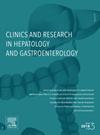肠肝轴:肥胖管理运动的新目标。
IF 2.4
4区 医学
Q2 GASTROENTEROLOGY & HEPATOLOGY
Clinics and research in hepatology and gastroenterology
Pub Date : 2025-09-16
DOI:10.1016/j.clinre.2025.102687
引用次数: 0
摘要
肠道生态失调是一种潜在的代谢功能障碍相关的脂肪变性肝病(MASLD)触发器,由于肠道渗漏和LPS泄漏(内毒素血症)。由于不存在特定的治疗方法,与肥胖的密切联系以及其多重触发因素,MASLD引起了科学界的关注。在这种情况下,体育锻炼是一种相关的非药物策略。然而,不同的强度和周期可以产生不同的结果,它们对肠肝轴的影响仍然不清楚。因此,本综述概述了运动(MICT或HIIT)对实验性肥胖模型中肠-肝轴调节的贡献,重点关注肠屏障和肝脏线粒体和内质网(ER)稳态。两种运动方案的效果可能与恢复紧密连接和改善肠道通透性有关。停止内毒素血症通过靶向内质网(ER)和线粒体来缓解MASLD,对抗糖脂毒性和炎症引起的紊乱,如内质网应激和线粒体失衡。尽管HIIT在增强肠道结构和微生物群多样性方面优于MICT,并可能因减少肥胖和改善胰岛素敏感性而减轻MASLD,但应鼓励定期运动,通过调节肠-肝轴来对抗肥胖流行。本文章由计算机程序翻译,如有差异,请以英文原文为准。
Gut-liver axis: An emerging target for exercise in obesity management
Gut dysbiosis emerged as a potential metabolic dysfunction-associated steatotic liver disease (MASLD) trigger due to leaky gut and LPS leakage (endotoxemia). MASLD attracts attention from the scientific community due to the non-existence of a specific treatment, the intimate connection to obesity, and its multiple triggers. In this context, physical exercise is a relevant non-pharmacological strategy. However, different intensities and periodicities can produce divergent results, and their impact on the gut-liver axis remains unraveled. Therefore, this comprehensive review outlines the contribution of exercise (MICT or HIIT) to modulating the gut-liver axis in experimental obesity models, with a focus on the intestinal barrier and hepatic mitochondrial and endoplasmic reticulum (ER) homeostasis. The effects of both exercise protocols are likely related to restoring tight junctions and improving gut permeability. Ceased endotoxemia alleviates MASLD by targeting the endoplasmic reticulum (ER) and mitochondria, countering disturbances caused by glucolipotoxicity and inflammation, like ER stress and mitochondrial dyshomeostasis. Although HIIT is superior to MICT in enhancing gut structure and microbiota diversity and possibly mitigating MASLD due to reduced adiposity and improved insulin sensitivity, regular exercise should be encouraged to counter the obesity pandemic by modulating the gut-liver axis.
求助全文
通过发布文献求助,成功后即可免费获取论文全文。
去求助
来源期刊

Clinics and research in hepatology and gastroenterology
GASTROENTEROLOGY & HEPATOLOGY-
CiteScore
4.30
自引率
3.70%
发文量
198
审稿时长
42 days
期刊介绍:
Clinics and Research in Hepatology and Gastroenterology publishes high-quality original research papers in the field of hepatology and gastroenterology. The editors put the accent on rapid communication of new research and clinical developments and so called "hot topic" issues. Following a clear Editorial line, besides original articles and case reports, each issue features editorials, commentaries and reviews. The journal encourages research and discussion between all those involved in the specialty on an international level. All articles are peer reviewed by international experts, the articles in press are online and indexed in the international databases (Current Contents, Pubmed, Scopus, Science Direct).
Clinics and Research in Hepatology and Gastroenterology is a subscription journal (with optional open access), which allows you to publish your research without any cost to you (unless you proactively chose the open access option). Your article will be available to all researchers around the globe whose institution has a subscription to the journal.
 求助内容:
求助内容: 应助结果提醒方式:
应助结果提醒方式:


